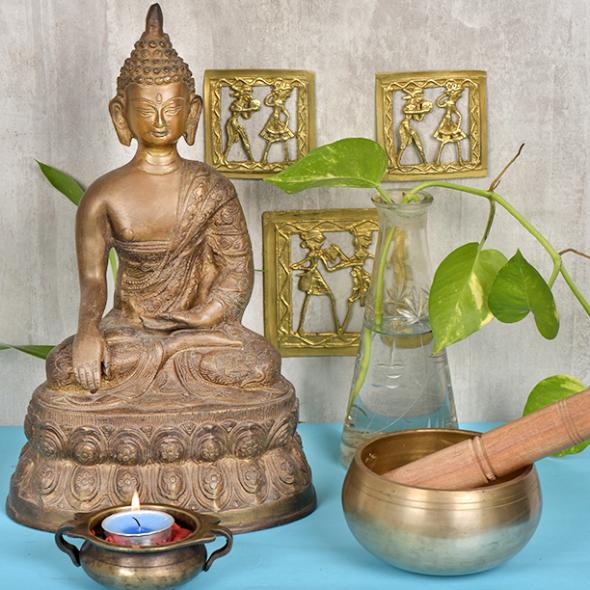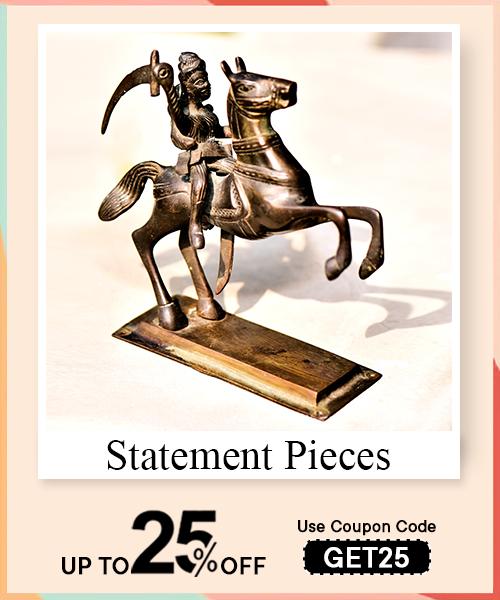Meditation is a unique way to help our minds feel calm and peaceful. It's like when you sit quietly and think about something nice, like a fluffy cloud or a twinkling star.
Meditation bowls are like magical musical instruments that make gentle and soothing sounds. They help us feel even more calm and happy when we use them while we meditate.
You can use the bowl gently, tapping it with a special stick or moving it around the edge. The sound makes you feel relaxed and cozy like soft raindrops falling on a window.
These unique bowls can also be used for other cool things! They can make us feel better when we massage or do yoga. They're like little helpers for handling excellent and healthy.
Remember, these bowls are like magical friends that want to help you feel super happy and relaxed. So, have fun trying different ways to use them and see what makes you think the best!
However, if you look closely, this is exactly the state of the mind most of the time, for most people. Life, after all, is not as simple as it appears to be.
Long hours of work, plenty of sense-attracting distractions, pressure to match the efforts of previous generations and living up to self-set expectations; factors like these send the mind spiraling into a tailspin of circles. This further leaves us with a restless mindset which slap-dashes our very existence and stings right back the resources of our material life when we least expect. While nature has its own intelligence to run the universe, this interference and obsession almost always leads us in wrong directions such as instant gratification, excessive entertainment, workaholic etc.
It’s the choice only of a brave warrior to dive straight into the heart and face the truth. Otherwise, for most people, mental noise is something which drives them unconsciously instead of them driving their own mind.

Meditation brings us inward. The practice allows us to come back into the infinite territory of our heart space. Before we go into further details of meditation, let’s take a dip into some insights about meditation, why it is important and how it affects our life.
What is Meditation?
The word ‘Meditation’ has been derived from a Latin word meditatio which implies ‘to contemplate, to ponder, to reflect upon’. In Tibetan, meditation is referred to by the word Gom, which means ‘to become familiar with one’s Self’. In other Asian religions, meditation is named after a popular word dhyana, which refers to ‘contemplation’.
All in all, meditation refers to the practice of focusing one’s mind for a period of time, in silence or with the help of mantras, in order to train it for the purpose of spirituality, self enquiry, peace or relaxation. The ultimate purpose of meditation is to train the mind to work for you and not against you.
What Meditation is Not?
Meditation is not sleeping. Furthermore, meditation is not a mind altering phenomenon unlike the trance or pleasure inducing substances. In fact, meditation has nothing to do with altering or change because, change cannot come without acceptance. And, acceptance can come only through awareness. And awareness, it can be realized only through the direct experience of meditation. In order to reach the blissful state of inner stillness, one must learn to meditate on a regular basis.
Meditation is not being better or more aware. It simply means dissolving the barriers that prevent you from being who you are.
Why Meditation?
Why do you drink water? Why do you sleep? Why do you earn money? Why do you interact and connect with other people?
A plain answer to each of the above questions can be summed up in one word. Needs.
Every human being is born with certain needs which include physical, emotional, mental, financial, creative, intellectual, social and spiritual. While people do lots of things to fulfil the basic material needs of physical, financial, social and intellectual, most of them fail to nourish their inner selves.

There is no map to fulfil the mental, emotional, psychological and spiritual needs. Meditation is the simplest and an excellent way to do just that. Having said this, it doesn’t imply that meditation can’t help you in the problems of your daily life. In fact, it is one of the best ways to contemplate and find answers to about any situation or issue. To describe it further, here are some quick bullets explaining how meditation can help you grow in your real life too.
For Employers & Employees
These days many organizations, corporate and big brands are starting meditation culture for their employees. It’s like denoting certain minutes in the work day as time blocks of meditation. While they improve the mental stillness of employees, their increased work efficiency benefits the companies too. It’s a kind of win-win situation both for employees and employers.
Therapy for Childhood Wounds
Each individual walks around with core wounds leaking their vitality and emotional pain holding them back to live to the fullest. Meditation is one of the most effective ways to heal these core emotional wounds. It acts as an additional therapy in addition to the professional psychology. Meditation helps you become aware of the negative self talk resulting from the wound, so that you can disintegrate it and reprogram it with new, empowering beliefs.
Stress Reduction
Stress can literally add fat to your belly, which cannot be sweated out even with boatloads of workout and exercise. It becomes a major cause for inflammation, leaky gut, brain fog, adrenal fatigue, hormonal problems and many such diseases. Meditation helps to decrease the levels of a hormone called cortisol in your blood, which is the major cause of stress locked in the body.
Inner Alignment & Balance
No wonder, the biggest benefit of meditation is inner stillness, which is perhaps the treasure of treasures one can ever receive. Inner stillness, satisfaction and contentment can help you face any challenge in life without disturbing your calm.
In simple words, Wanting to have peace of mind but not wanting to meditate is just like wanting to be the greatest boxer but not wanting to get punched in the face.
Why do we run away from Meditation?
There is a famous quote by Swami Chinmayananda which elaborates the answer to this question. It is, “A spiritually established life is not an easy task. But a materially satisfied life is an impossible task.” In other words, we can always lose what is temporary so why not take a chance to look into a place where there is everlasting happiness. That is, within. Anyhow. Moving on.
How to Meditate?
Now that you have a fair idea of what meditation is all about and why should you meditate, the next question which comes up is, How do you meditate?
Let’s throw some light on it.
Meditation is non-doing. What does that mean? It means shattering of all inner boundaries, settling all the busyness and just being a witness to whatever is happening in your inner world. Following are some simple steps to begin with.
Some Basic Steps for Meditation for Beginners-
1. Set a Time Block
Meditation is easier said than done. Therefore, before you begin the practice, it’s important to really set the intention, commit to yourself and block a time in your daily time table.
2. Select a Comfortable Seating Position
It doesn’t always need to be a separate meditation room. It can be anything, from as simple as a corner of your bed, or a chair. Just make sure that the space is your personal and it is relatively comfortable.
3. Sit, Close Your Eyes and Relax
Start by getting your spine straight as much as you can. If you don’t have a habit of sitting with crossed legs for long periods of time, you might need cushions to support your hips and back. Once you have it all together, just relax your shoulders and your entire body. Let it settle like the water of a lake.
4. Focus On The Movement Of Breath
Focus on your nostrils and the area above lips. Feel the air of the breath as you inhale it, as you exhale it. Slowly slowly, withdraw your attention more inwards to observe the total movement of your breath from your nostrils to your belly and the other way.
5. Let The Mind Wander
As you concentrate on your breath, you’ll observe that your mind wanders a lot. Just like a monkey jumps from one tree to the other. Let it wander where it wants to. You just need to watch it all quietly. When the thoughts arise, watch them. When they pass away, watch them. Don’t hold on or attach. Just witness.
6. Stay With It
Keep note of how you feel. Sometimes emotions or memories may surface during meditation. If it is a negative emotion, don’t try to run away from it. Whatever arises, just stay with it.
7. Smile!
Once your time block is over, gently brush your eyelids with your palms and open your eyes. Smile that you did it!
Different Techniques of Meditation
Having gone through the basic understanding of meditation, let’s now explore different kinds of techniques you can use to meditate. Although there are thousands of ways to meditate, here we will discuss five of the most common meditation techniques.
1. Body Scan Meditation
Body is the temple of the soul. And the wonder of wonders a human being has received as a gift from nature. The wisdom of body is unmatchable. This technique focuses on this fact. In this meditation, the meditator focuses one’s attention on the sensations of the body. Begin from the top of head and move down to your feet, or the other way round. The key to paying attention to sensations is to gain more bodily awareness and to unlock the emotional blocks.
2. Journal Meditation
Take a notebook. Take a pen. Sit down in a corner where no one will disturb you. Now, take a few breaths to relax your mind and let the faucet open. Little by little, jot down the stream of your thoughts. The idea is to not stop until finished. Maybe you want to do it for five minutes, or maybe you can do it for an hour. Whatever it might be, just let it come to light so that you can reflect upon your mind while reading it later on. This is also known as Stream of Consciousness Meditation.
3. Singing Bowl Meditation
Singing Bowl Therapy is gaining popularity not just for therapists but for general population as well. In addition to being a simple meditation technique, a meditation bowl offers a way to calm your mind in the most effortless way possible. It is even said that a singing meditation bowl releases waves of frequency which can harmonize and align the balance of mind-body-spirit of the listener. Don’t know where to look? Check out a stunning collection of meditation bowls on Indianshelf.
You can read also: 7 Different Ways of Using Singing Bowls in Your House
4. Mindfulness Meditation
The great poet and Sufi mystic Rumi says, This moment is all there is. Cultivating mindfulness in our daily routine helps us to embrace and enjoy the moment tenfolds. The key is, whatever you do, do it with total awareness. If you’re walking, only walk. If you’re listening, just listen. If you’re sitting, just watch your thoughts as they wander. If you’re eating, only eat. And so on. Apart from being one of the best meditation techniques for beginners, this is so easy to practice even for people with most hectic lifestyles.
5. Loving Kindness Meditation
One of the greatest meditation tips all the great holy men have to offer is to cultivate compassion and kindness in our heart. This, after all, is the biggest goal of meditation too. Loving Kindness meditation practice finds its origins in Buddhism. Also known as Maitri, it refers to developing an unconditional bond or friendship with one’s self. We can also call it, making friends with our demons.
Summing Up
Meditation is one habit which, when developed with practice and discipline paves a way to continuous growth and everlasting inner transformation for an individual as one’s life flows with time. Carrying within, a warrior like fire and ocean like water, when an individual goes through life, the individual grows through it too. Meditation is the tool.
Summarizing with a famous saying by Buddha, “It’s better to conquer yourself than to win a thousand battles. Then the victory is yours. It cannot be taken away from you.”



















